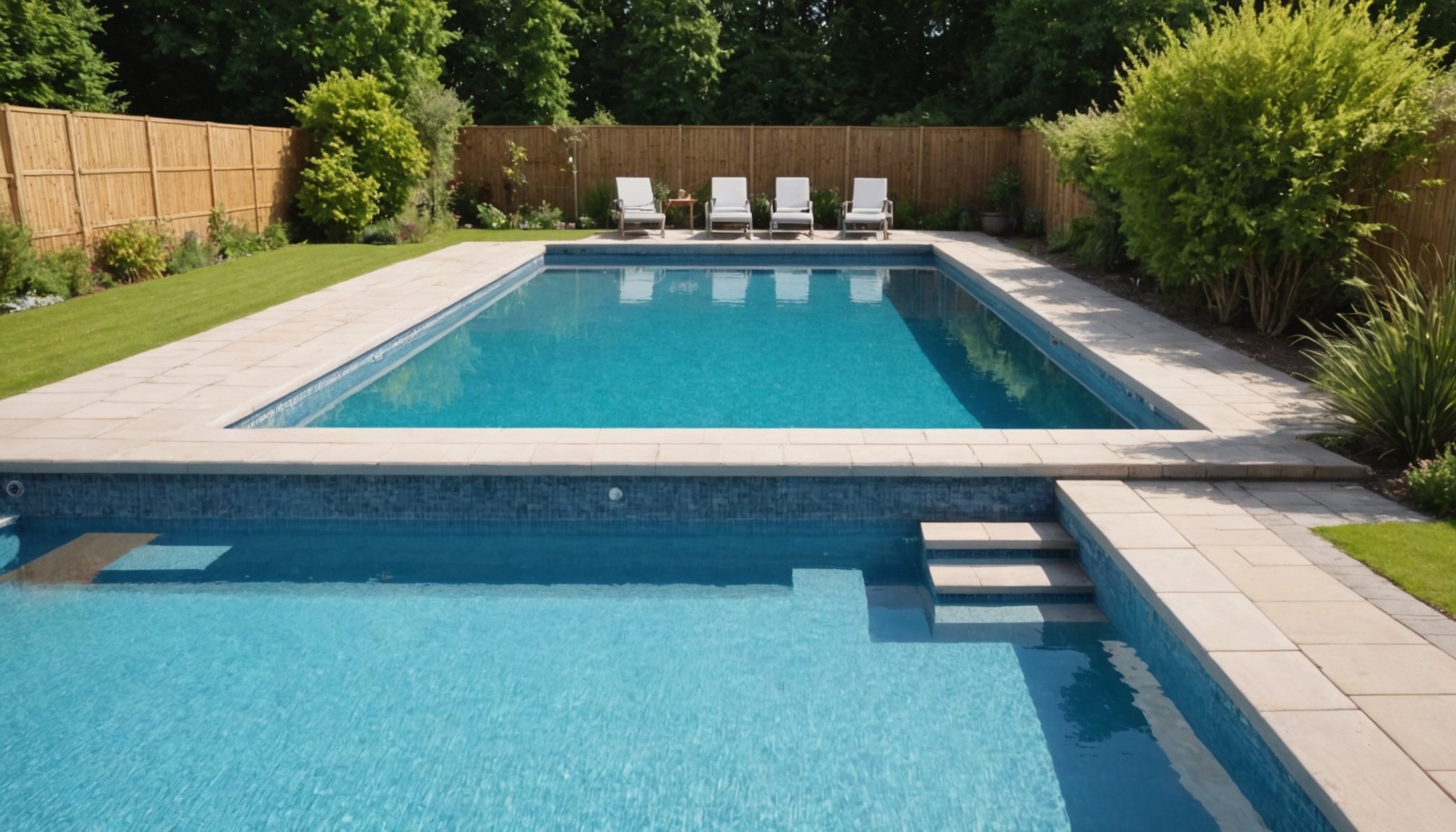Understanding the Need for Pool Safeguarding
Maintaining pool safety during extended pool closing is critical, particularly in the UK, where safeguarding procedures are stringent. While a closed pool might seem inactive, there are unseen risks associated with prolonged disuse. Neglecting the maintenance of a closed pool can lead to water stagnation, which may promote the growth of harmful bacteria and algae. These microorganisms not only ruin the aesthetic quality of the pool but also pose significant health risks to future users.
Moreover, mechanical systems and equipment may degrade if not regularly inspected and maintained. For instance, filtration systems can become clogged and ineffective after a period of inactivity. Addressing these risks is crucial to ensure the pool remains in excellent condition for reopening.
A lire en complément : Top Pool Accessories That Thrive in the UK”s Ever-Changing Weather
In the UK, regulations around pool maintenance during closures emphasize routine checks and balanced water chemistry. Regular inspections and cleaning are required to ensure compliance with safety standards. Owners must adhere to these guidelines to safeguard a swimming pool effectively. This encompasses both private and public facilities, with the latter often subjected to more rigorous checks due to their communal use. Prioritizing pool safety safeguards the well-being of swimmers and prolongs the infrastructure’s lifespan.
Pool Maintenance Before Closure
Proper pre-closure maintenance of your swimming pool is crucial in ensuring its health and longevity through the colder months. Start by cleaning the pool thoroughly, as removing debris and scrubbing surfaces helps maintain water quality and prevents algae growth. It’s vital to brush the pool walls and vacuum the floor to eliminate any lurking bacteria or dirt.
A découvrir également : Effective Strategies to Combat Hard Water Damage on Your UK Swimming Pool Equipment
Attention to chemical balance is equally important. Test and adjust the pool’s pH levels, alkalinity, and chlorine levels to prevent corrosion and scale accumulation. Proper balance reduces the risk of microbial contamination and prolongs the pool’s lifespan.
Furthermore, with preparation for closure comes the crucial step of draining and protecting pool equipment. Lower the water level according to your pool type and cover standards, ensuring no risk of surface or structural damage. Remember to empty filters, pumps, and heaters to avoid freezing damage.
Integration of these steps into your pool care routine guarantees seasonal protection, making the task of opening the pool in the spring far simpler. By thoroughly addressing swimming pool care before closure, pool owners can save time and money while preserving their backyard oasis’ integrity.
Chemical Balancing Techniques
Ensuring a proper chemical balance in your pool is essential for maintaining water quality and preventing issues like algae growth. It’s recommended to test pool chemicals at least once a week. This allows you to adjust as needed and keep the pool safe for swimming. For some pools, depending on usage and weather conditions, more frequent testing might be beneficial.
Different types of pools require specific chemical levels. Chlorine levels, for example, should be maintained between 1-3 ppm for residential pools, while commercial pools might need higher levels due to increased usage. pH levels should generally sit between 7.2-7.6, as this range is optimal for swimmers and prevents damage to pool surfaces and equipment.
During pool closures, algae can become a persistent challenge. To combat this, consistently balance chemicals and consider adding algaecide. Covering the pool can help restrict light to the water, mitigating algae growth.
To summarise, maintaining water quality starts with understanding the specific chemical needs of your pool. Regular testing and adjustments ensure a balanced environment, preventing common problems and extending the life of the pool and its components.
Covering Your Pool Effectively
When considering methods for protecting pool areas, choosing the right covering techniques can significantly enhance safety and maintenance.
Types of Pool Covers
Different pool covers cater to various needs, and understanding these can guide you to the best choice. Solid covers offer robust protection by blocking sunlight, which helps prevent algae growth. However, they can be cumbersome and may require pumps to remove water accumulation. Mesh covers, on the other hand, allow water to drain through, reducing the maintenance burden. They are lighter but less effective in preventing debris. Automatic covers provide convenience at a higher cost and can ensure better energy efficiency in warm months. Selecting a cover depends on your budget, climate, and how often you use your pool. Consider what is most important for you and your pool protection needs.
Installation Tips
Proper installation requires attention to detail. Begin by ensuring the cover is the correct size for your pool. Carefully position it over the surface, ensuring it’s snug and secure. Use anchors and straps to prevent it from being lifted by the wind. Regularly checking the secure fit is essential, especially during closure periods, to maintain effective coverage and protection against weather conditions.
Equipment Maintenance
Proper pool equipment maintenance is crucial for extending the lifespan of your gear. Regular checks ensure their efficiency and prolong their functionality.
Essential Equipment to Check Before Closure
Before closing your pool for any extended period, it’s critical to inspect essential components like the pump and filter. Look for any signs of wear and tear that could affect performance. A visual inspection helps identify problems early, enabling timely intervention.
Correct Measures for Winterizing the Pump and Filter
Winterizing your pump and filter is a vital step in prolonging equipment life. To begin, ensure the pump and filter are free from debris, as any leftover particles can cause rust or freeze damage. Draining water from these components prevents cracks due to freezing temperatures. Consult the manufacturer’s guidelines for specific winterization steps.
Storing Removable Equipment to Avoid Damage
Properly storing removable pool equipment is another key aspect of equipment upkeep. Items such as ladders, floaters, and pool cleaner hoses should be cleaned and stored in a dry, sheltered area. This prevents exposure to elements that can lead to deterioration. Cover pool surfaces with a durable cover to offer protection from harsh winter conditions, further contributing to your equipment’s longevity.
Emergency Preparedness
When ensuring emergency pool safety, it’s crucial to establish a solid monitoring schedule, especially during closures. Regular checks help to identify potential hazards before they become a serious issue. Keeping an eye on any changes, such as water level drops or malfunctioning equipment, can prevent accidents and keep the pool area secure.
Additionally, preparing for adverse weather impacts is paramount in maintaining pool safety. Extreme weather such as heavy rains or high winds can lead to unexpected debris in the pool or damage to safety barriers. Equip your pool with a reliable cover and ensure that all loose items are securely stored. This proactive approach minimizes the impact of severe weather, providing peace of mind.
In instances where expert assessment is required, do not hesitate to contact professionals for thorough pool inspections. They possess the expertise to spot less obvious issues and recommend effective solutions. Regular inspections are essential to detect structural problems or sanitation concerns early, ensuring the safety of all swimmers.
Being proactive in these respects allows for comprehensive emergency precautions, fostering a safe and enjoyable swimming environment for all. Prioritising emergency preparedness facilitates peace of mind and maximises safety year-round.
Compliance with UK Regulations
Navigating UK pool regulations can be an intricate task for homeowners with private swimming pools. To ensure legal compliance, it’s essential to have a grasp of the pertinent swimming pool safety laws specific to your region.
Homeowners are bound by a number of regulations meant to safeguard users. Swimming pool safety laws in the UK often cover a spectrum of requirements such as fencing, signage, and water safety measures. It is the homeowner’s responsibility to not only be aware of these regulations but also to implement them effectively.
Regular updates and changes to these laws necessitate a proactive approach. A failure in keeping the pool area compliant can lead to fines or other legal consequences. Therefore, understanding homeowner responsibilities should be a priority for anyone who owns or plans to install a swimming pool.
There are numerous resources available to stay informed about the latest regulations. Government websites and local councils often provide comprehensive guides and updates. Enlisting the help of professionals who specialize in pool safety can also be a practical approach in maintaining compliance. Homeowners must schedule regular inspections to verify their pool meets all required safety standards consistently.
Conclusion: Best Practices for Homeowners
Safeguarding a home pool is not just a seasonal task. It requires consistent attention and adherence to best practices. Homeowners should consider a few crucial steps to maintain pool safety effectively. Firstly, implementing regular maintenance checks ensures that all equipment is functioning efficiently and that the water remains safe for use. Regular checks can prevent unexpected malfunctions and reduce long-term repair costs.
It is essential to establish a routine for monitoring chlorine levels, the pH balance, and filter operation. Moreover, homeowners should pay attention to timely cleaning procedures, such as skimming leaves or debris and vacuuming the pool floor, to maintain optimal water clarity. These practices significantly contribute to maintaining a healthy swimming environment.
During periods of non-use, such as off-season closures, homeowners must not neglect pool care. Securing the pool with a sturdy cover can prevent accidents and limit the accumulation of debris. Drainage systems should also be checked to avoid water stagnation which could lead to harmful algae growth.
In conclusion, maintaining pool safety is a continuous responsibility. By adhering to these homeowner tips, pool owners can enjoy a hassle-free swimming experience while ensuring the well-being of their family and guests.












